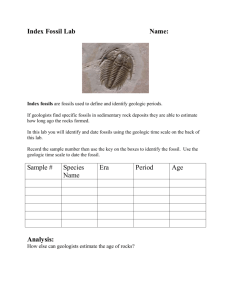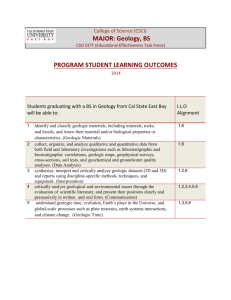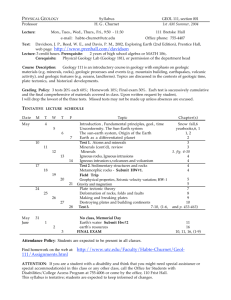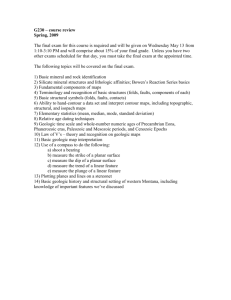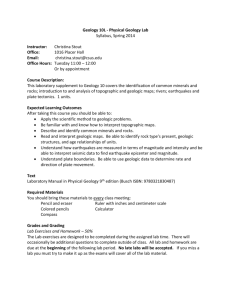Geology 101 - Great Basin College
advertisement
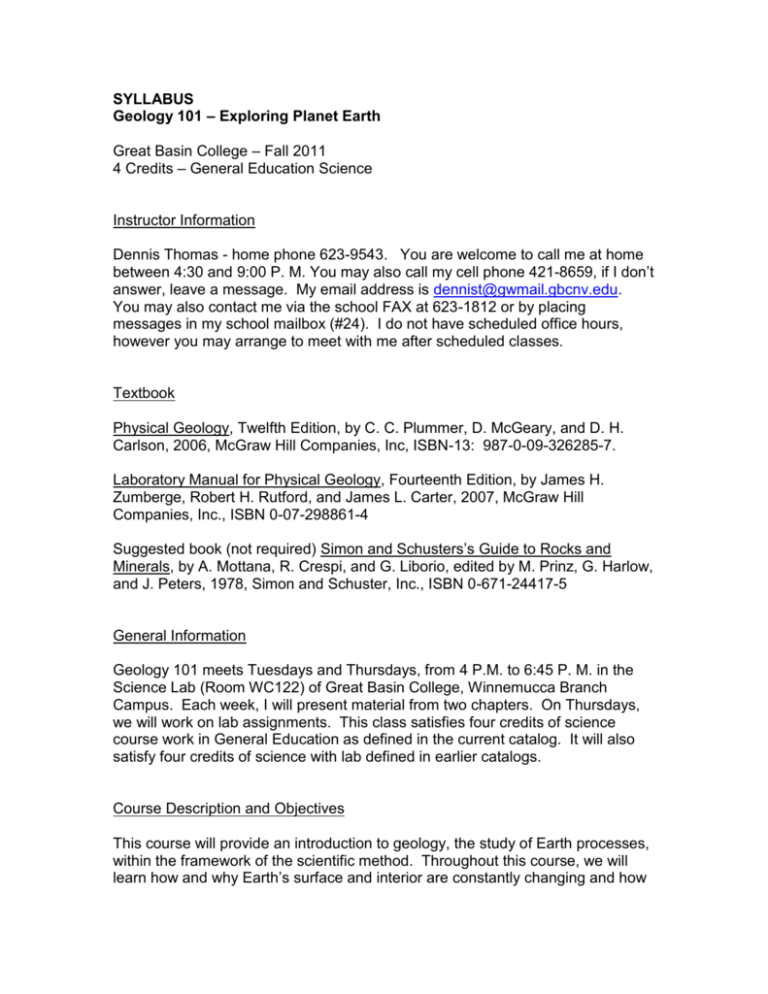
SYLLABUS Geology 101 – Exploring Planet Earth Great Basin College – Fall 2011 4 Credits – General Education Science Instructor Information Dennis Thomas - home phone 623-9543. You are welcome to call me at home between 4:30 and 9:00 P. M. You may also call my cell phone 421-8659, if I don’t answer, leave a message. My email address is dennist@gwmail.gbcnv.edu. You may also contact me via the school FAX at 623-1812 or by placing messages in my school mailbox (#24). I do not have scheduled office hours, however you may arrange to meet with me after scheduled classes. Textbook Physical Geology, Twelfth Edition, by C. C. Plummer, D. McGeary, and D. H. Carlson, 2006, McGraw Hill Companies, Inc, ISBN-13: 987-0-09-326285-7. Laboratory Manual for Physical Geology, Fourteenth Edition, by James H. Zumberge, Robert H. Rutford, and James L. Carter, 2007, McGraw Hill Companies, Inc., ISBN 0-07-298861-4 Suggested book (not required) Simon and Schusters’s Guide to Rocks and Minerals, by A. Mottana, R. Crespi, and G. Liborio, edited by M. Prinz, G. Harlow, and J. Peters, 1978, Simon and Schuster, Inc., ISBN 0-671-24417-5 General Information Geology 101 meets Tuesdays and Thursdays, from 4 P.M. to 6:45 P. M. in the Science Lab (Room WC122) of Great Basin College, Winnemucca Branch Campus. Each week, I will present material from two chapters. On Thursdays, we will work on lab assignments. This class satisfies four credits of science course work in General Education as defined in the current catalog. It will also satisfy four credits of science with lab defined in earlier catalogs. Course Description and Objectives This course will provide an introduction to geology, the study of Earth processes, within the framework of the scientific method. Throughout this course, we will learn how and why Earth’s surface and interior are constantly changing and how the interaction of air, water, and solid material creates the mountains, rivers and oceans. Understanding the ‘big picture’ will help your understanding of every concept in this course. There will be lectures, laboratory exploration and a field trip that will provide an opportunity you develop a good basic understanding of physical geology. You will write a term paper, give an oral presentation to the class, answer questions asked in class, participate in small lab workgroups and discussion groups. These exercises are intended to enhance you ability to communicate clearly and effectively. The labs will provide you with hands-on opportunities to learn the scientific principles of geologic investigation, basic geologic concepts, and enhance your ability to think critically. You will learn how to read topographic and geologic maps, identify common rocks and minerals, recognize fossil types, and calculate simple Earth movement solutions. Measurements of Expected Course Outcomes (objectives) The above objectives will be measured by: 1. Your development of a general appreciation of the geologic framework of Earth will be determined from tests, participation and discussion. Comprehension of the fundamental concepts of geology will be determined by tests, laboratory exercises and participation in class discussions. 2. Recognize how the study of geology contributes to the supplying the things we need, protecting the environment, and avoiding geologic hazards will be tested by exams and participation in discussions and from written assignments intended to enhance personal/cultural awareness of the role of geology in society. 3. Examine your understanding of the scientific method in problem solving and critical thinking, and recognizing the hierarchy of scientific knowledge it creates will be established though lab exercises and reports. 4. Communication skills will be evaluated by your oral presentation of research conducted primarily through Internet investigation. Student Responsibilities You must participate in classes if you intend to obtain the full benefits of instruction. You may be dropped from the class if your absences become excessive. More than 4 absences without legitimate excuses is considered excessive in a four-credit course. You are expected to read the material before coming to class. I will ask questions throughout each lecture to keep track of how well you are grasping the material and will expect your participation. Take written notes and be sure to ask questions. If you do not understand, it is likely your classmates don’t either. Assignments must be on time to get full credit for your work. Points will be deducted for late work. I will reduce your earned grade by 10% for each day the assignment is late. Your work will not be accepted after the work of other students has been returned to them. If you know you cannot take an exam during the scheduled time, you must make arrangements to take the test at another time before the test is scheduled. Should you miss an exam because of an emergency, you may make it up so long as you provide appropriate written documentation of the emergency. Withdrawing from the Course Great Basin College allows you to withdraw from a class before the end of the thirteenth week of the semester and receive a W on your grade report and transcript. This date is November 25, 2010. You must do this if you plan to drop the class. If you do not formally withdraw, I will give you a letter grade based on the points you achieved in class. Students may request ‘incomplete’ status if they are unable to complete the class on time, but want an opportunity to finish. You must be passing when you have completed 75% of the coursework. Incomplete status is granted for compelling cause, usually family emergencies, medical emergencies or employment emergencies, although other reasons will be considered. Please request incomplete status from me in writing by December 1. The request must include a statement of the work that must be completed for a final grade and the reason for your request. Your outstanding coursework must be submitted by March 15, 2012, or your grade will automatically revert to a W. Grade values are as follows: A AB+ B BC+ C CD+ D DF I W Superior Above Average Average Below Average Failure Incomplete Withdrawal 4.0 3.7 3.3 3.0 2.7 2.3 2.0 1.7 1.3 1.0 0.7 0.0 Course Assignments and Points Possible There are 1,000 points possible in this course. The points you earn from the exams, lab assignments, class participation, and reports will determine your grade. The points are distributed as follows: Midterm Exam 1 Midterm Exam 2 Midterm Exam 3 Final Exam 100 points 100 points 100 points 200 points Lab Assignments (9) Lab Exam Field Trip Report 160 points 75 points 65 points Term Project 200 total points Conference with instructor 10 points Reference list 10 points Rough Draft 30 points Final Paper 100 points (Content 75 pts., references and citations 10 pts., organization 5 pts., grammar and spelling 10 pts.) Oral Presentation 50 points The highest score attained in the class will be considered 100% of the points possible. Each 10% below that high score will mark the cutoff for the A-B-C-D-F grades. Exams The three midterm exams and the final will be taken in class, or as a take-home at the discretion of the instructor. There will not be any new material presented on exam day. The exams may include essay responses, multiple choice questions, true-false responses, drawing or labeling diagrams or charts, fill in the blank, matching, or defining terms. These exams will test your understanding of the assigned reading in the test. On each exam points will be added to the highest score to make it total 100%. The same amount of points will also be added to the rest of the scores. Labs Assignments will consist of classroom work, fieldwork and observations. We will learn mineral and rock identification, geologic dating and history, learn to read many types of maps, explore geologic structures, take a field trip, and investigate ore deposits and mining. Each classroom lab will have a 20-point assignment that you may be able to complete on the lab night; however, you may work on it when the science lab is open, and turn it in to me at the beginning of the next lab night. There are nine lab assignments, and your lowest lab assignment score will not be used to calculate your grade. A comprehensive test of the material presented during labs will be conducted at the end of the course. There will be a field trip on Saturday, October 22. At the discretion of the instructor, some short field trips may be taken during class time. The required typewritten report on the trip should include observations of the field trip stops. Include information about what we discussed, where we went, and how the weather was. Be as detailed as possible. I encourage the use of drawings or photographs to illustrate important aspects of the trip. The report will be worth 65 points and will be graded on completeness of the information, and writing quality (spelling, grammar, organization). It will be due November 3, regardless if you accompanied the class or you are self-guided. Research Paper A typewritten research paper will be required for this class. You may consider most any aspect of physical geology for your research subject, however I must approve it. Some suggested topics include: Earthquakes in Nevada Geology of a particular mine or National Park Geologic History of Nevada Sedimentary rocks in Northern Nevada Geologic Hazards in Nevada Volcanic Rocks in Northern Nevada Groundwater Resources in Nevada Geothermal Energy in Nevada Oil Resources in Nevada Your paper should be at least five but not more than twenty pages (not including the front matter, references cited and figures). Your research should include a minimum of three references other than your text. The facts of your research will be attributed to the source of the information. I prefer the APA style, citing writer and date in parentheses following the fact or paragraph, or citing the writer in the text and including the date in parentheses. You may also include photographs, diagrams or other illustrations but be sure to cite the work of others. Other requirements for preparation for your paper include: By September 22, meet with me to discuss your report. This meeting will establish the topic for your research; make certain that you know what I expect the report to cover and so I can help you find research material for the report. By October 13, turn in a typed reference list (a list of references you may use in your report). You may expand this list during your research. No later than November 17, you must turn in a double spaced rough draft of your paper. This is to determine if you have covered the topic well, and to identify technical writing problems you should address before turning in your final paper. Be prepared to turn in your final paper and present your oral summary of your research by December 6. Oral Presentation of Research You will also be required to present your research orally to the class. Your presentation should be a summary of the research (reading your paper to the class will not be acceptable). Your presentation must be between 5 and 30 minutes in length. You are encourages to include visual aides, such as transparencies, slides, or computer projections. You may also use PowerPoint or videotapes so long as they are your own work. Written Assignments All written assignments shall be in 12-point font, double line spaced, left justified in dark ink on pale paper. Consult the writing lab if you need information about writing reports. Tutors are available to provide assistance with technical writing skills, research approaches and review or proof reading of you papers. Students with Disabilities If you are a student with a disability and you require assistance and special accommodations for classes call the Counseling Office, 775.753.2279. Substantiation of the incorporation of the General Education Objectives into Geology 101: Communication Skills (strong component): Some test questions are short essay in nature, requiring clear communication of the understanding of geologic processes. The use of appropriate sketches and graphs in communicating ideas is promoted. In the lab, written descriptions of the rocks that students identify are required. Also, two complete lab write-ups on quantitative investigations (following the format of scientific investigation) are required. Class discussion is encouraged. Critical Thinking (strong component): Quantitative Ability (significant): Several of the labs specifically require measurement, mathematic manipulation of the data, and the creation of graphs. Quantitative relationships are used in creation of topographic maps through interpolation of survey points and in the creation of topographic cross sections. Students learn latitude and longitude (with an introduction to GPS) and the use of the Land Office Grid System (section, township, range). Students are introduced to the use of the Brunton compass, the measurement of planar orientation with strike and dip, and they learn the three dimensional relationships between topography and geologic structure. The difference in arrival times of p and s waves generated from earthquakes is used to determine the location of earthquakes from seismograph data. Reasoning and Independent Thought (significant): All lab exercises require reasoning and independent thought based on the interpretation of both qualitative and quantitative information. For mineral and rock identification, observations and simple physical tests must be made to determine the unique physical properties and compositions. This information is then interpreted to correctly identify the mineral or rock. There is more reasoning in this exercise than most students realize. The interpretation of landforms represented on topographic maps and geologic structures represented on geologic maps both require reasoning. The written labs require the use of the scientific method format, where appropriate conclusions must be drawn from the data and calculated results. Many test questions require reasoning taken from the understanding and application of the processes of geology, not just the memorization of terms (though of course, they must know the meanings of the terms too). Scientific Understanding (significant): All principles taught in this course are based on scientific reasoning. All interpretations are given as they are based upon facts. The lab introduces the use of the scientific method and the use of both observational and quantifiable facts in its application. The underlying effects of energy from gravity, stream velocity, internal and solar heat, and other sources are discussed. The chemical nature of rocks and minerals is shown. The scientific basis for evolution shown in the fossil record is reviewed, and its application to the geologic time scale is emphasized. Geologic time and the position of the earth within time and the universe is reviewed. Students are taught that every feature of the earth is the result of specific processes that can be understood and interpreted by those who are knowledgeable of these processes. Personal and Cultural Awareness (moderate component): Sense of the Individual in Society (considerable): This objective is also reflected under the “Sense of Accountability” objective below. We discuss the right of the individual to build anywhere one desires versus societies’ willingness to compensate the individual for losses incurred from natural disasters, especially when a high likely-hood of the disaster is known (examples: building on flood plains or barrier islands in hurricane prone areas, etc.). A global view of geological processes is given that shows that they have no deference to any race, creed, or cultural factor. Different social attitudes to geologic hazards in different cultures are reviewed. Sense of the Past (considerable): This class lives deeper in the past than most would probably like to accept as the goal of this objective. We show human history as only a tiny blip on the screen of time. What can be emphasized is the sharp impact of humans on the surface of the planet in a short period of time, but we can also show how insignificant we are at the same time. In addition, the historical basis for the development of important geologic ideas is presented. Examples include the constancy of interfacial angles of crystals being an early evidence of atomic structure, the history of the interpretation of ice ages, the role of geology in the development of evolutionary theory, the development of new technology advancing the state of knowing (such as using radiometric age dating), etc. Finally, the development of human societies, arts, and industry are all intimately related to the utilization of mineral resources through past ages, thus the terms “Stone”, “Bronze”, “Iron”, and “Atomic” ages. The impact of fossil fuels on modern society is discussed. Sense of Accountability (significant): A common theme throughout much of this course is the interaction between humans and nature, and the personal and social consequences of these interactions. These interactions range from geologic hazards (floods, earthquakes, volcanic eruptions, mass wasting, etc.) through resource utilization (minerals, fossil fuels, ground water utilization, etc.) through the effects of pollution on natural systems (pollution of ground water, global temperature change, etc.). The acts of individuals and society through building and land use planning are discussed, using examples of costs to tax payers (through government reimbursement after “disasters”) when individuals build in flood plains, low coastal areas susceptible to hurricanes, earthquakeprone areas, etc. The question of what rights society has to regulate activities in these kinds of areas is posed. Appreciation of Fine Arts (some degree): The development of the fine arts in some areas parallels to development and use of mineral resources, and this type of information is presented during the course of the class. Examples are found in the history of pigments and paints (mineral and petroleum based) and the development of ceramics. Modern sculpture relies on mineral resources. Greek and Roman Art is shown and discussed. Personal Wellness (some degree): Personal safety is considered in the discussion of geologic hazards (first reactions to earthquakes, safe places to build or buy homes, etc., are examples). Potential sources of groundwater pollution are shown. Technological Understanding (moderate component): Internet links are shown to sites giving current earthquake reports, past flood data for the United States, etc. GPS units and their use are going to be incorporated into the labs on maps and location. Tentative Schedule A tentative schedule of your reading assignments, lecture topics and important dates is attached. Consult the Great Basin Class Schedule or the General Catalog for other important dates. Geology 101 DATE 30 August 1 September 6 September 8 September 13 September 15 September 20 September 22 September 27 September 29 September 4 October 6 October 11 October 13 October 18 October 20 October 22 October 24 October 27 October 1 November 3 November 8 November 10 November 15 November 17 November 22 November 24 November 29 November 1 December 6 December 8 December 15 December READING 1-27 Lab 27-79 Lab 80-133 Lab 136-191 1-191 192-245 Lab 246-305 Lab 382-436 Lab 193-305 & 382-436 Lab 9 AM-3PM 338-381 Lab 306-337 Lab 441-489 489-525 306-337 338-381 441-581 526-549 Lab 550-581 All labs All of Book FALL 2011 TENTATIVE SCHEDULE TOPIC Class Introduction & Introduction to Physical Geology Crystal systems / Mineral Properties Atoms, elements, Minerals, Igneous Rocks, Intrusive Activity Identification of Common Minerals Volcanism, Extrusive Rocks Igneous Rocks Weathering and Soil Sedimentary, Metamorphic and Hydrothermal Rocks FIRST MID TERM EXAM (Chap. 1–7)– Report Topics Due Geologic Time, Mass Wasting Sedimentary Rocks Streams and Floods, Ground Water Metamorphic Rocks Structure, Earthquakes Relative Dating– Reference List due SECOND MID TERM EXAM (Chap. 8 – 12) Topographic Maps SATURDAY FIELD TRIP Deserts, Wind, Waves, Beaches and Coasts Geologic Maps Glaciers Geologic Cross Sections– Field Trip Report due Earth’s Interior, The Sea Floor Plate Tectonics THIRD MIDTERM EXAM (Chap. 13 – 19) Mountains and Continents – Draft Paper due Tectonic Plates Thanksgiving Holiday Geologic Resources LAB EXAM Oral Presentations begin / Final Paper Due Oral Presentations Continue / Review for final exam FINAL EXAM (7:00 PM)

